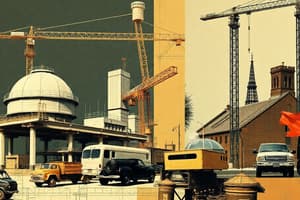Podcast
Questions and Answers
What type of forces do the top and bottom members of a truss sustain?
What type of forces do the top and bottom members of a truss sustain?
- Compression and tension (correct)
- Shear and bending
- Torsion and shear
- Only compression
What type of forces can a truss member be subjected to?
What type of forces can a truss member be subjected to?
- Axial forces
- Shear forces
- Bending forces
- All of the above (correct)
What is the function of chord members in a truss bridge?
What is the function of chord members in a truss bridge?
- Resist forces caused by bending (correct)
- Support the deck and transfer its load to beams
- Carry shear forces
- Transfer the loads to the beams
What is the primary function of stringers in a truss bridge?
What is the primary function of stringers in a truss bridge?
What is the role of the floor beams in a truss bridge?
What is the role of the floor beams in a truss bridge?
Truss members may only be subjected to axial forces and not bending or shear forces
Truss members may only be subjected to axial forces and not bending or shear forces
I-shaped beams and trusses are not good options to better handle the forces in a truss bridge
I-shaped beams and trusses are not good options to better handle the forces in a truss bridge
Chord members in a truss bridge resist forces caused by bending
Chord members in a truss bridge resist forces caused by bending
Floor beams in a truss bridge are parallel to the traffic direction
Floor beams in a truss bridge are parallel to the traffic direction
The deck in a truss bridge does not carry the loads directly
The deck in a truss bridge does not carry the loads directly
Truss structures are less efficient in exploiting the strengths of materials compared to beams because they only resist axial forces in members.
Truss structures are less efficient in exploiting the strengths of materials compared to beams because they only resist axial forces in members.
The very top and bottom of a truss beam sustain bending forces, while diagonal members sustain shear forces.
The very top and bottom of a truss beam sustain bending forces, while diagonal members sustain shear forces.
Chord bracing is responsible for ensuring truss stability and resisting wind loads in a truss bridge.
Chord bracing is responsible for ensuring truss stability and resisting wind loads in a truss bridge.
Stringers in a truss bridge are transverse to the traffic direction.
Stringers in a truss bridge are transverse to the traffic direction.
I-shaped beams and trusses are not good options to better handle the forces in a truss bridge.
I-shaped beams and trusses are not good options to better handle the forces in a truss bridge.
Flashcards are hidden until you start studying
Study Notes
Truss Bridge Forces
- Top and bottom members of a truss sustain axial forces
- Truss members are subjected to axial forces only, not bending or shear forces
Truss Bridge Members
- Chord members resist forces caused by bending
- Stringers are transverse to the traffic direction
- Floor beams are parallel to the traffic direction
Truss Bridge Functionality
- The primary function of stringers is to support the deck
- The deck does not carry the loads directly
Truss Bridge Structure
- Truss structures are less efficient in exploiting the strengths of materials compared to beams
- Chord bracing ensures truss stability and resists wind loads
Studying That Suits You
Use AI to generate personalized quizzes and flashcards to suit your learning preferences.




